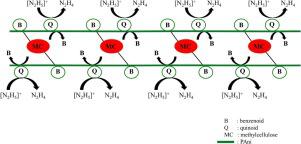Sensors and Actuators A: Physical ( IF 4.1 ) Pub Date : 2020-11-24 , DOI: 10.1016/j.sna.2020.112460 Hazira Hussin , Seng-Neon Gan , Sook-Wai Phang

|
In this study, water-soluble polyaniline-methylcellulose complex (PAni-MC) was applied as an environmental friendly chemical sensor for hydrazine detection. PAni was rendered water-soluble through chemical modification with MC. Fourier transform infrared (FTIR) and Ultraviolet-visible (UV–vis) spectroscopies confirmed the chemical structures of PAni-MC to be the conducting emeraldine salt form with electrical conductivity values of 0.068 S cm−1 for pristine PAni and 0.132 S cm−1 for PAni-MC respectively. In the hydrazine detection procedure, PAni-MC solution was added into samples containing various concentrations of hydrazine (10−100 ppm) and the sensor responses were recorded using a conductivity meter. Several parameters have been studied, including (i) different volume ratio of PAni to hydrazine, (ii) different mass ratio of aniline (Ani) monomer to MC, and (iii) detection at low concentration range of hydrazine (1−10 ppm). From the results obtained, PAni-MC (volume ratio 2:5 of PAni-MC: hydrazine) with the mass ratio 0.2:1 of Ani: MC has achieved the best sensitivity of 0.0143 ppm−1, hence it was selected to further study its sensor performance. Calibration has shown a good sensitivity of 0.0132 ppm-1 and a good linear correlation (R2 = 0.9953), the limit of detection (LOD) of 0.55 ppm, and the limit of quantitation (LOQ) of 1.82 ppm respectively. The sensor performance was supported by UV–vis and FTIR analyses. Significant decrease in the UV–vis absorbance was observed at bipolaron (∼821 nm) and polaron (∼450 nm) bands, meanwhile the intensity of quinoid/benzenoid (IQ/IB) ratio in the FTIR spectra has shown a decrease from 1.03 to 0.97. In real sample analysis, PAni-MC eventually indicated the best recovery range of 96–136 % and a good relative standard deviation (RSD) of 2.69–5.84 %.
中文翻译:

用于水合肼检测的水性聚苯胺传感器的开发
在这项研究中,水溶性聚苯胺-甲基纤维素复合物(PAni-MC)被用作检测肼的环保化学传感器。通过MC的化学修饰使PAni变成水溶性的。傅里叶红外光谱(FTIR)和紫外可见光谱(UV-Vis)证实了PAni-MC的化学结构是导电的翡翠盐形式,原始PAni的电导率为0.068 S cm -1,电导率为0.132 S cm -1分别用于PAni-MC。在肼检测程序中,将PAni-MC溶液添加到包含各种浓度的肼(10-100 ppm)的样品中,并使用电导率仪记录传感器的响应。已经研究了几个参数,包括(i)PAni与肼的不同体积比,(ii)苯胺(Ani)单体与MC的不同质量比,以及(iii)在低浓度的肼(1-10 ppm)下检测。根据得到的结果,质量比为Ani:MC的质量比为0.2:1的PAni-MC(PAni-MC的质量比为2:5)达到了0.0143 ppm -1的最佳灵敏度,因此选择进行进一步研究。它的传感器性能。校准显示出0.0132 ppm -1的良好灵敏度以及良好的线性相关性(R 2= 0.9953),检测限(LOD)为0.55 ppm和定量限(LOQ)为1.82 ppm。传感器性能得到UV-Vis和FTIR分析的支持。在显著减少UV-Vis吸收在双极化(~821纳米)和极化子(~450纳米)带中观察到,醌/苯(I的同时强度Q / I乙在FTIR光谱)的比率呈现出从减少1.03至0.97。在实际样品分析中,PAni-MC最终表明最佳回收率范围为96-136%,良好的相对标准偏差(RSD)为2.69 – 5.84%。











































 京公网安备 11010802027423号
京公网安备 11010802027423号